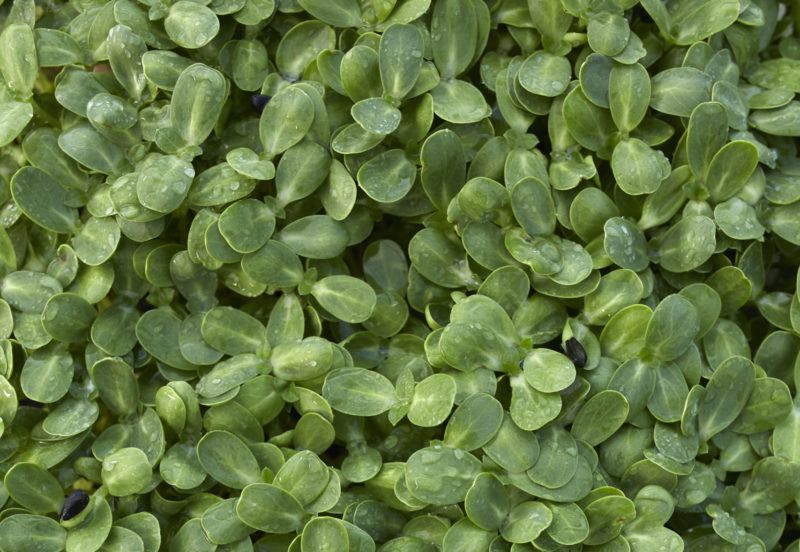
Tiny Crop, Big Returns
October 20, 2020
Written By Adam Buckallew
Microgreens Fuel Growth at Farmboy Garden
Richard Leiweke was staring at a bag of pea seeds that was past its prime, and he was tempted to throw it out with the garbage because he had serious concerns about its ability to germinate. Years earlier he had read stories of people raising microgreens from the same type of peas, but he had dismissed the idea, fearing there would be no market in Missouri for such a trendy foodstuff.
“People here in the Midwest sometimes look at you funny when you bring up microgreens” Leiweke says. “They think that sounds like something for people who live on the East or West Coast.”
As Leiweke, a self-described tightwad, thought more about the bag of seed, he realized it would only take a minimal investment of garden soil to experiment with the miniature crop, so he moved forward.
The low-risk experiment has paid off for Leiweke and his family’s fresh produce business, Farmboy Garden, where microgreens now account for roughly 60 percent of sales.
Small but Mighty
The seedlings of any edible vegetables or herbs can be used to produce microgreens. While microgreen is more marketing term than botanical distinction, it is commonly used to describe the tender foliage of young plants harvested at the cotyledon stage, typically seven to 14 days after planting.
These immature greens—typically shorter than the length of a credit card—are prized for their rich flavors, vibrant colors, crisp textures and strong nutrient profile. A 2012 study that assessed vitamin and phytonutrient concentrations across 25 varieties of microgreens found that almost all the microgreen leaves researchers examined contained four to six times more nutrients than the leaves of their fully grown counterparts. Certain varieties, like red cabbage, were found to have up to 40 times more vitamin E than the mature leaves of the same plant.
“Because microgreens are harvested right after germination, all the nutrients they need to grow are there,” says Qin Wang, an associate professor at the University of Maryland and one of the researchers who conducted the microgreen nutritional assessment. “If they are harvested at the right time, they are very concentrated with nutrients.”
Leiweke currently markets 14 varieties of microgreens including kale, peas, red cabbage, arugula, broccoli, radish, pak choi and sunflower shoots. He’s grown other varieties such as cilantro and beets, but those take longer to produce (four to six weeks), and he currently doesn’t have the space to handle those slower growing crops.
The first time Leiweke tasted microgreens, he couldn’t believe the flavor he experienced.
“I’m no rabbit,” he says while finishing a barbecue sandwich. “I don’t regularly eat a lot of salads, but the bold flavor you get from microgreens is incredible. If you were to try my carrot microgreens, you would swear you just ate a baby carrot that was dipped in sugar because it tastes so sweet.”
Second Act
Leiweke, who is 58, grew up on the same farm in Gerald, Mo., where he and his wife, Denise, now reside. “My dad called me one day back in 1994 and told me he was thinking of selling the farm,” Leiweke recalls. “I said, ‘No, you sold the farm’ and that was that.”
Leiweke routinely has on a pair of blue Big Smith overalls and sports a wispy white beard that frames a friendly smile. Though he dropped out of school after the seventh grade, he speaks eloquently and is a skilled tinkerer who has rigged a number of contraptions that have improved the productivity of his greenhouse operations.
“Everything I know I’ve figured out the hard way,” he says with a grin.
The modified washer Leiweke built to clean his used microgreen trays can sanitize a flat in 30 seconds – a major improvement from the three per seven minutes he could manage when using a standard power washer. Timely cleaning is important for keeping the small business humming, and ensuring the containers start disease free for the next crop.
Elsewhere in the greenhouse, a hopper—used to quickly fill flats with horticultural-grade soil in preparation for seeding—has been outfitted with a salt truck vibrator to break up clumps and keep the dirt filtering downward efficiently.
Though he grew up on a farm, Leiweke began his career in construction. For 28 years he worked as a general contractor before a series of heart attacks forced him to find a new occupation.
“My wife told me it was time to find a different line of work, and farming was really the only other thing I knew,” Leiweke says.
He soon discovered his experience raising row crops with his father did not directly translate to his venture into growing farm fresh vegetables.
“The difference was night and day,” Leiweke says. “We had a family garden when I was a boy, but this is a completely different experience. The pests are not the same and there are way more fungal concerns.”
Step into the greenhouse where Leiweke tends to his microgreens, and you will hear the soft whirring of 16 overhead fans that run round the clock. The constant airflow is crucial to keeping mold and fungal pathogens at bay while the young seedlings grow.
Everything grown in Leiweke’s four greenhouses is raised naturally. You won’t find any herbicide or pesticide on the premises. The only thing applied to his crops above the soil is water—a selling point that resonates with grocery shoppers.
Growing Demand
Since its founding in 2014, Farmboy Garden has grown steadily, thanks in large part to the “accidental addition” of microgreens to its list of products. The retail price of the microgreens varies by grocer, but consistently sells for less than $4 per 2-ounce container.
“We would still just be raising vegetables if we hadn’t stumbled onto microgreens,” Leiweke says. “The demand for microgreens has really ballooned and is growing considerably.”
The Leiwekes still raise tomatoes, cucumbers, zucchini, yellow squash, bell peppers and basil, but they’ve scaled back their vegetable production significantly. Whereas they once grew five or six different types of peppers, they now sell a single variety.
While Richard has concentrated on microgreens, Denise has taken over managing the year-round vegetable operation and doubles as quality controller. “She doesn’t let anything go out that we wouldn’t eat ourselves.”
Growing and harvesting vegetables commercially is labor-intensive, and the shift in focus to microgreens has allowed the Leiwekes to make better use of their workforce.
Finding good help is a challenge in rural Franklin County. The majority of Leiweke’s crew of seven employees are above the age of 60, including his father, Jerry, who is 87. The Leiwekes have tried hiring younger workers but find they rarely stick, including four that were hired in the first half of August that didn’t pan out.
Despite the hiring challenges, Farmboy Garden continues to grow thanks to establishing relationships with grocers like Frick’s Market in Union, Mo., and Straub’s in the St. Louis, Mo., metro area.
Leiweke’s latest customer, natural food market Fresh Thyme, is currently offering his products in six stores and has expressed interest in broadening distribution to the chain’s remaining 72 stores based on strong sales. That would require making deliveries to Fresh Thyme’s distribution center in the Chicago area—a job that would, at the moment, fall to Leiweke, who already spends the bulk of his time managing the company’s logistics.
Expansion Plans
Richard rises most days by 3 a.m., which gives him time to talk with his brother and business partner, Mark, who’s been working as a security contractor in Kuwait. The brothers video chat daily to discuss their business, its growth and plans for the future.
The Leiwekes are currently in the midst of finalizing plans to significantly expand their greenhouse operations, and build a packing facility and warehouse. The expansion, slated for construction in November, would double their number of greenhouses, creating more room for microgreens and two additional houses for tomatoes to cover year-round production needs. The added space will enable the microgreen prep and harvest area to be moved out of the greenhouses where Richard says they are “chewing up space that should be used to grow something.”
Freeing up more room for plants inside the greenhouses will allow the Leiwekes to make better use of their limited climate-controlled spaces.
“When you run greenhouses, you want to maximize your square inches – not square feet,” Richard says. “Every square inch in a greenhouse is critical.”

